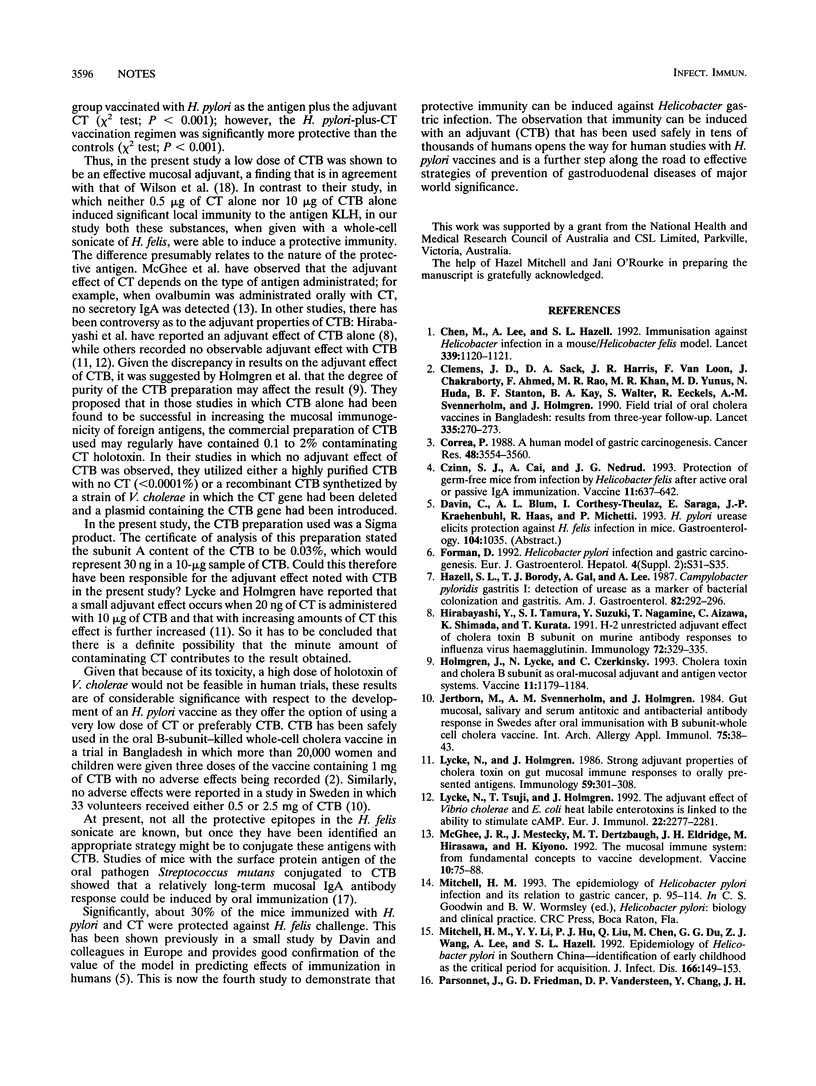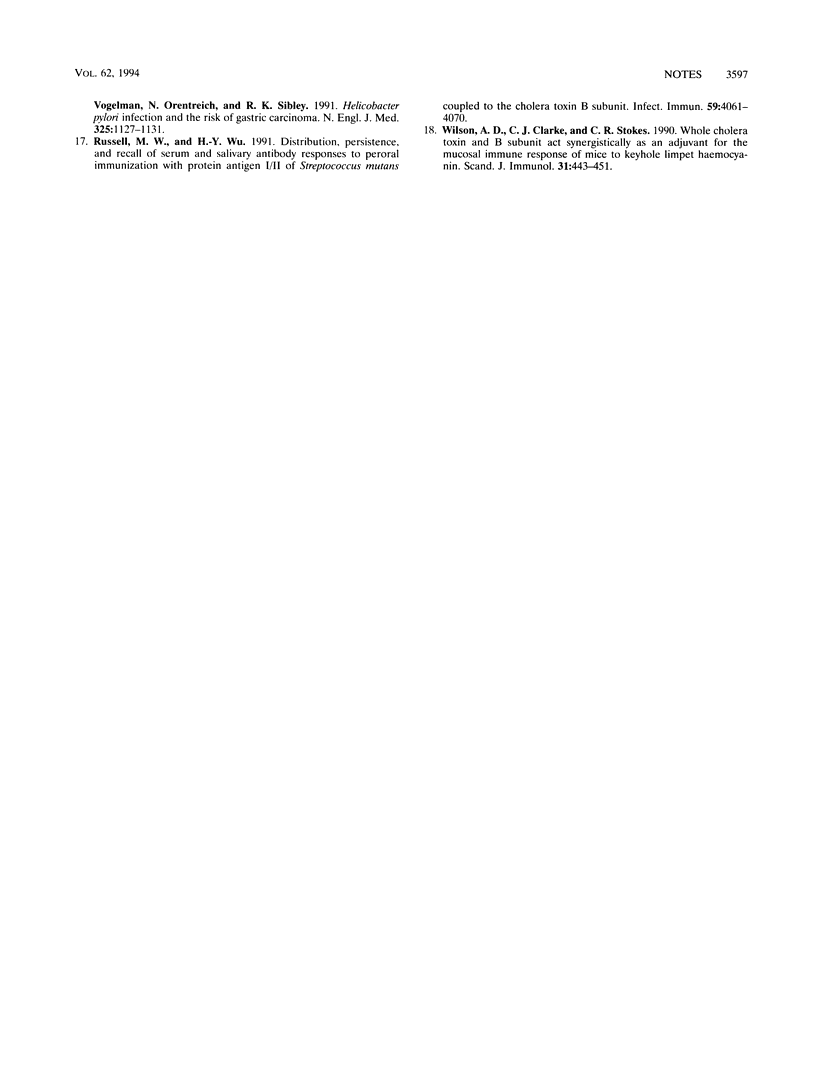Abstract
In previous studies we found that immunizing mice with a sonicate of Helicobacter felis and adjuvant cholera toxin (CT; 10 micrograms) protected the animals against challenge with viable H. felis. The aim of this study was to determine whether a low dose of CT or its nontoxic B subunit (CTB) was effective as an adjuvant in Helicobacter oral vaccines. Significant protection against viable H. felis challenge was achieved in the animals immunized with H. felis antigen plus the combination of 0.5 microgram of CT and 10 micrograms of CTB (96%), with H. felis antigen plus 0.5 microgram of CT (95%), and with H. felis antigen plus 10 micrograms of CTB (83%). No protective effect was found in the mice immunized with either H. felis antigen alone or adjuvant CTB and CT alone. Twenty-six percent of mice immunized with Helicobacter pylori antigen plus CT (10 micrograms) were protected against H. felis challenge, confirming the value of the model in predicting effects of immunization in humans. The observation that immunity can be induced with a nontoxic adjuvant CTB opens the way for human studies with H. pylori vaccines and is a further step along the road to effective strategies of prevention of gastroduodenal diseases of major world significance.
Full text
PDF



Images in this article
Selected References
These references are in PubMed. This may not be the complete list of references from this article.
- Chen M., Lee A., Hazell S. Immunisation against gastric helicobacter infection in a mouse/Helicobacter felis model. Lancet. 1992 May 2;339(8801):1120–1121. doi: 10.1016/0140-6736(92)90720-n. [DOI] [PubMed] [Google Scholar]
- Clemens J. D., Sack D. A., Harris J. R., Van Loon F., Chakraborty J., Ahmed F., Rao M. R., Khan M. R., Yunus M., Huda N. Field trial of oral cholera vaccines in Bangladesh: results from three-year follow-up. Lancet. 1990 Feb 3;335(8684):270–273. doi: 10.1016/0140-6736(90)90080-o. [DOI] [PubMed] [Google Scholar]
- Correa P. A human model of gastric carcinogenesis. Cancer Res. 1988 Jul 1;48(13):3554–3560. [PubMed] [Google Scholar]
- Czinn S. J., Cai A., Nedrud J. G. Protection of germ-free mice from infection by Helicobacter felis after active oral or passive IgA immunization. Vaccine. 1993;11(6):637–642. doi: 10.1016/0264-410x(93)90309-l. [DOI] [PubMed] [Google Scholar]
- Hazell S. L., Borody T. J., Gal A., Lee A. Campylobacter pyloridis gastritis I: Detection of urease as a marker of bacterial colonization and gastritis. Am J Gastroenterol. 1987 Apr;82(4):292–296. [PubMed] [Google Scholar]
- Hirabayashi Y., Tamura S. I., Suzuki Y., Nagamine T., Aizawa C., Shimada K., Kurata T. H-2-unrestricted adjuvant effect of cholera toxin B subunit on murine antibody responses to influenza virus haemagglutinin. Immunology. 1991 Mar;72(3):329–335. [PMC free article] [PubMed] [Google Scholar]
- Holmgren J., Lycke N., Czerkinsky C. Cholera toxin and cholera B subunit as oral-mucosal adjuvant and antigen vector systems. Vaccine. 1993 Sep;11(12):1179–1184. doi: 10.1016/0264-410x(93)90039-z. [DOI] [PubMed] [Google Scholar]
- Jertborn M., Svennerholm A. M., Holmgren J. Gut mucosal, salivary and serum antitoxic and antibacterial antibody responses in Swedes after oral immunization with B subunit-whole cell cholera vaccine. Int Arch Allergy Appl Immunol. 1984;75(1):38–43. doi: 10.1159/000233587. [DOI] [PubMed] [Google Scholar]
- Lycke N., Holmgren J. Strong adjuvant properties of cholera toxin on gut mucosal immune responses to orally presented antigens. Immunology. 1986 Oct;59(2):301–308. [PMC free article] [PubMed] [Google Scholar]
- Lycke N., Tsuji T., Holmgren J. The adjuvant effect of Vibrio cholerae and Escherichia coli heat-labile enterotoxins is linked to their ADP-ribosyltransferase activity. Eur J Immunol. 1992 Sep;22(9):2277–2281. doi: 10.1002/eji.1830220915. [DOI] [PubMed] [Google Scholar]
- McGhee J. R., Mestecky J., Dertzbaugh M. T., Eldridge J. H., Hirasawa M., Kiyono H. The mucosal immune system: from fundamental concepts to vaccine development. Vaccine. 1992;10(2):75–88. doi: 10.1016/0264-410x(92)90021-b. [DOI] [PubMed] [Google Scholar]
- Mitchell H. M., Li Y. Y., Hu P. J., Liu Q., Chen M., Du G. G., Wang Z. J., Lee A., Hazell S. L. Epidemiology of Helicobacter pylori in southern China: identification of early childhood as the critical period for acquisition. J Infect Dis. 1992 Jul;166(1):149–153. doi: 10.1093/infdis/166.1.149. [DOI] [PubMed] [Google Scholar]
- Parsonnet J., Friedman G. D., Vandersteen D. P., Chang Y., Vogelman J. H., Orentreich N., Sibley R. K. Helicobacter pylori infection and the risk of gastric carcinoma. N Engl J Med. 1991 Oct 17;325(16):1127–1131. doi: 10.1056/NEJM199110173251603. [DOI] [PubMed] [Google Scholar]
- Russell M. W., Wu H. Y. Distribution, persistence, and recall of serum and salivary antibody responses to peroral immunization with protein antigen I/II of Streptococcus mutans coupled to the cholera toxin B subunit. Infect Immun. 1991 Nov;59(11):4061–4070. doi: 10.1128/iai.59.11.4061-4070.1991. [DOI] [PMC free article] [PubMed] [Google Scholar]
- Wilson A. D., Clarke C. J., Stokes C. R. Whole cholera toxin and B subunit act synergistically as an adjuvant for the mucosal immune response of mice to keyhole limpet haemocyanin. Scand J Immunol. 1990 Apr;31(4):443–451. doi: 10.1111/j.1365-3083.1990.tb02791.x. [DOI] [PubMed] [Google Scholar]



